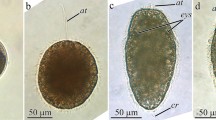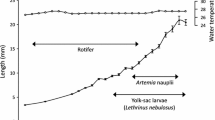Summary
Larvae of Hydractinia echinata, a colonial marine hydroid, can be triggered experimentally to undergo metamorphosis into polyps. The efficiency of induction is density-dependent: a high larval density allows fewer larvae to metamorphose than a low density. Culture medium of metamorphosing larvae was found to contain taurine as the major constituent of its inhibitory activity. The concentration of taurine in larvae is 90 mM which is much higher than that of other free amino acids. Taurine interferes effectively with the onset of metamorphosis if applied externally at a concentration equivalent to 1/1000 of the animal's overall internal concentration. Upon induction of metamorphosis the larva releases three quarters of its taurine into the medium. Taurine may have a function in control of onset of metamorphosis because, applied exogenously in micromolar quantities, it stabilizes the larval state, i.e. the larvae resist metamorphosis-inducing stimuli. The chemically related compounds 4-aminobutyric acid (GABA) and β-alanine are much less effective. There exist other larval state stabilizing compounds in Hydractinia including homarine, trigonelline, betaine and methionine. These compounds are though to act by delivering methyl groups leading to the production of S-adenosylmethionine. Taurine is not able to supply methyl groups. Furthermore, in contrast to the four other compounds taurine does not interefere with the advance of metamorphosis when applied after induction, and of these five substances, only taurine is released upon induction of metamorphosis.
Similar content being viewed by others
References
Berking S (1984) Metamorphosis in Hydractinia echinata. Insights into pattern formation in hydroids. Wilhelm Roux's Arch 193:370–378
Berking S (1986a) Is homarine a morphogen in the marine hydroid Hydractinia? Wilhelm Roux's Arch 195:33–38
Berking S (1986b) Transmethylation and control of pattern formation in hydrozoa. Differentiation 32:10–16
Berking S (1987) Homarine (N-methylpicolinic acid) and trigonelline (N-methylnicotine acid) appear to be involved in pattern control in a marine hydroid. Development 99:211–220
Berking S (1988) Ammonia, tetraethylammonium, barium and amiloride induce metamorphosis in the marine hydroid Hydractinia. Roux Arch Dev Biol 197:1–9
Davison AN, Kaczmarek LK (1971) Taurine — a possible neurotransmitter? Nature 234:107–108
Freeman G, Ridgway EB (1987) Endogenous photoproteins, calcium channels and calcium transients during metamorphosis in hydrozoans. Roux's Arch Devl Biol 196:30–50
Grega DS, Werz MA, MacDonnald RL (1987) Forskolin and phorbol esters reduce the same potassium conductance of mouse neurons in culture. Science 235:345–348
Gruener R, Bryant HJ (1975) Excitability modulation by taurine. Action of axon membrane permeabilities. J Pharmacol Exp Ther 194:514–521
Jacobson JG, Smith LN (1968) Biochemistry and physiology of taurine and taurine derivatives. Physiol Rev 48:424–511
Leitz T, Müller WA (1987) Evidence for the involvement of PI-signaling and diacylglycerol second messengers in the initiation of metamorphosis in the hydroid Hydractinia echinata Fleming. Dev Biol 121:82–89
Lombardini JB (1985) Effects of taurine on calcium ion uptake and protein phosphorylation in rat retinal membrane preparations. J Neurochem 45:268–275
McBride WJ, Frederickson RCA (1980) Taurine as a possible inhibitory neutrotransmitter in the cerebellum. Fed Proc 39:2701–2705
Mondino A, Bongiovanni G, Fumero S, Rossi L (1972) Improved method of plasma deproteination with sulfosalicylic acid for determining amino-acids and related compounds. J Chromatogr 74:255–263
Müller WA (1973) Metamorphose-Induktion bei Planulalarven. I. Der bakterielle Induktor. Wilhelm Roux's Arch 173:107–121
Müller WA (1985) Tumor-promoting phorbol esters induce metamorphosis and multiple head formation in the hydroid Hydractinia. Differentiation 29:216–222
Müller WA, Buchal G (1973) Metamorphose-Induktion bei Planulalarven. II. Induktion durch monovalente Kationen: Die Bedeutung des Gibbs-Donnan-Verhältnisses und der Na + /K + -ATPase. Wilhelm Roux's Arch 173:122–135
Müller WA, Mitze A, Wickhorst J-P, Meier-Menge HM (1977) Polar morphogenesis in early hydroid development: action of caesium, of neutrotransmitters and of an intrinsic head activator on pattern formation. Wilhelm Roux's Arch 182:311–328
Netherton JC, Gurin S (1982) Biosynthesis and physiological role of homarine in marine shrimp. J Biol Chem 257:11971–11975
Oja SS, Lähdesmäki P (1974) Is taurine an inhibitory neurotransmitter? Med Biol 52:138–147
Spindler K -D, Müller WA (1972) Induction of metamorphosis by bacteria and by a lithium-pulse in the larvae of Hydractinia echinata (Hydrozoa). Wilhelm Roux's Archiv 169:271–280
Wright CE, Lin T, Lin YY, Sturman JA (1984) Taurine reacts with HOCl in cultured cells. Fed Proc 43:616
Wright CE, Tallan HH, Lin YY (1986) Taurine:biological update. Annu Rev Biochem 55:427–453
Author information
Authors and Affiliations
Rights and permissions
About this article
Cite this article
Berking, S. Taurine found to stabilize the larval state is released upon induction of metamorphosis in the hydrozon Hydractinia. Roux's Arch Dev Biol 197, 321–327 (1988). https://doi.org/10.1007/BF00375951
Received:
Accepted:
Issue Date:
DOI: https://doi.org/10.1007/BF00375951




